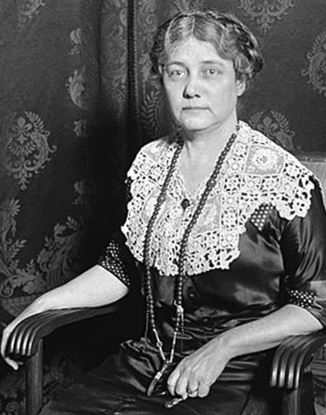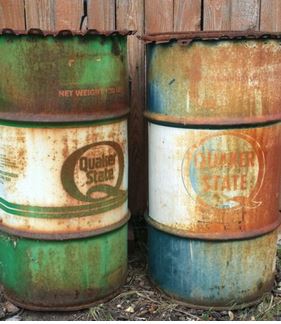
(The image above is of author and Stunt Reporter Elizabeth Cochran Seaman, circa 1916).
We have been looking at her remarkable life this week because her pen-name became a real one in our Family. She was widely known as “Nellie Bly,” a name taken from an old Stephen Foster song. Elizabeth made her name by investigating conditions at an infamous mental institution and made a trip around the world in less than 80 days. An indication of her talent and skill was the manufacture of the first practical 55-gallon oil drum.
That last note justifies some of the things Nellie Bly accomplished. We conveyed her rise to fame with travelogues from Mexico, exposes of how women were treated in mental institutions, and most significantly, her 72-day dash around the world by ship, train and rickshaw. The trip and subsequent publicity jaunts had left her exhausted, but she returned to high-visibility journalism in September of 1893 with the front-page headline story: “Nellie Bly Again.”
Among her best reporting in the decade after her global circumnavigation was her coverage of the Pullman Palace Car Company strike of 1894, in which she outlined the plight of workers living in “company towns,” at the mercy of the company for salaries and prices in the stores.
The impact of covering these sorts of stories was pervasive and left Nellie depressed. By 1895, she left the World for a five-week stint at the Chicago Times-Herald. There was a personal stunt in the Windy City to be achieved as well. On April 5, 1895, Bly secretly wed industrialist Robert Livingston Seaman, a seventy-year-old New York industrialist. She was thirty-one.
They had a stormy first year together. Seaman’s family suspected Bly might be a gold-digger and caused enough trouble over money that Bly decided she had to go back to work. She interviewed political figures on some of the social issues of the day that affected women: marriage and suffrage were prime among them, but the connection between war times then and now are stark. Nellie proposed recruiting a regiment of women to fight for Cuba against Spain. That effort was too radical for America then, but the idea lingered long enough to form a basis for establishing special Service Corps to later support the Navy and Army.
Nellie’s activities shook her husband, and they decamped to Europe to save their marriage. Joseph became ill and for three years Bly nursed him in failing eyesight. Seaman appreciated her efforts and changed his will to make her sole beneficiary. Returning to the States for the change of Millennia they lived quietly until Seaman died in 1904. Bly was immersed in running Seaman’s Iron Clad Manufacturing Company, and by 1905 held 25 patents for products under her own name- whichever one she was using!
Her innovative spirit was captured in marketing products to help American families. She designed, manufactured, and marketed the first successful American steel barrel in a factory she tried to make a model of social welfare for her 1,500 employees. This led to a first failure for Nellie Bly as her Iron Clad Manufacturing Company fell prey to employees who embezzled perhaps as much as $1.6 million. Fights about that continued to 1914 and the outbreak of The Great War in Europe.

(55-Gallon Drums designed by Nellie are still in use today all over the world!)
Four days after Austria declared war on Serbia, Bly set out for Vienna, seeking financing for her Iron Clad offshoot, American Steel Barrel Company. War production did her company well. In addition to commercial activity she wrote pro-Austrian stories and stayed in Vienna until the end of the war in 1918. She worked tirelessly for the welfare of widows and orphans.
This is the period in which Nellie joined our family. Our Elizabeth’s spirit was captured by one of the rambunctious Uncles in their hometown in southern Pennsylvania where stories of the original Nellie Bly’s adventures were published in Pittsburgh. She reveled in her new name and the aura of adventure it brought to her life.
In 1919, she returned to New York City where the bright lights and social activism pulsed with energy. At the New York Journal she created an advice column not dissimilar to the Dear Abby of our times. By 1921, she told readers she had placed thousands of children in happy homes and provided thousands of unwed mothers with new chances. Bly died January 27, 1922, and has a memorial on Roosevelt island in New York.
She didn’t deliberately select our Elizabeth as the recipient of the pen-name she would no longer be using, but sometimes things just work out the way they do, you know?
Our Aunt Bly wound up married to a Physician in West Virginia. It was startling to see the connection tumble through the generations this week. Our Literary Lady lasted on to a time when the name became hers to do with as she pleased. She had the spirit of the Stunt Journal Girls, and she just renewed it for our whole family!
Copyright 2021 Vic Socotra
www.vicsocotra.com
